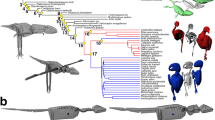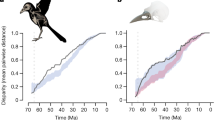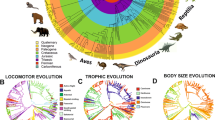Abstract
Birds show tremendous ecological disparity in spite of strong biomechanical constraints imposed by flight. Modular skeletal evolution is generally accepted to have facilitated this, with distinct body regions showing semi-independent evolutionary trajectories. However, this hypothesis has received little scrutiny. We analyse evolutionary modularity and ecomorphology using three-dimensional data from across the entire skeleton in a phylogenetically broad sample of extant birds. We find strongly modular evolution of skeletal element sizes within body regions (head, trunk, forelimb and hindlimb). However, element shapes show substantially less modularity, have stronger relationships to ecology, and provide evidence that ecological adaptation involves coordinated evolution of elements across different body regions. This complicates the straightforward paradigm in which modular evolution facilitated the ecological diversification of birds. Our findings suggest the potential for undetected patterns of morphological evolution in even well-studied groups, and advance the understanding of the interface between evolutionary integration and ecomorphology.
This is a preview of subscription content, access via your institution
Access options
Access Nature and 54 other Nature Portfolio journals
Get Nature+, our best-value online-access subscription
$29.99 / 30 days
cancel any time
Subscribe to this journal
Receive 12 digital issues and online access to articles
$119.00 per year
only $9.92 per issue
Buy this article
- Purchase on Springer Link
- Instant access to full article PDF
Prices may be subject to local taxes which are calculated during checkout





Similar content being viewed by others
Data availability
The specimen sources, scan parameters and metadata are reported in the Supplementary Information. All scans and 3D objects are available at www.morphosource.org/projects/00000C420, and the dataset is described in Bjarnason and Benson47.
Code availability
R version 3.63 was employed to run the analyses. The packages and functions used are described in detail in the Methods with citations. The codes written by assembling these pre-built functions are available upon request.
References
Cheverud, J. M. Developmental integration and the evolution of pleiotropy. Am. Zool. 36, 44–50 (1996).
Wagner, G. P. & Altenberg, L. Perspective: complex adaptations and the evolution of evolvability. Evolution 50, 967–976 (1996).
Wagner, G. P., Pavlicev, M. & Cheverud, J. M. The road to modularity. Nat. Rev. Genet. 8, 921–931 (2007).
Klingenberg, C. P. Morphological integration and developmental modularity. Annu. Rev. Ecol. Evol. Syst. 39, 115–132 (2008).
Klingenberg, C. P. Studying morphological integration and modularity at multiple levels: concepts and analysis. Phil. Trans. R. Soc. B 369, 20130249 (2014).
Hallgrímsson, B. et al. Deciphering the palimpsest: studying the relationship between morphological integration and phenotypic covariation. Evol. Biol. 36, 355–376 (2009).
Olson, E. & Miller, R. Morphological Integration (Univ. of Chicago Press, 1958).
Pigliucci, M. Phenotypic integration: studying the ecology and evolution of complex phenotypes. Ecol. Lett. 6, 265–272 (2003).
Eble, G. J. in Phenotypic Integration: Studying the Ecology and Evolution of Complex Phenotypes (eds Pigliucci, M. & Preston, K.) 253–273 (Oxford Univ. Press, 2004).
Goswami, A., Smaers, J. B., Soligo, C. & Polly, P. D. The macroevolutionary consequences of phenotypic integration: from development to deep time. Phil. Trans. R. Soc. B 369, 20130254 (2014).
Goswami, A., Binder, W. J., Meachen, J. & O’Keefe, F. R. The fossil record of phenotypic integration and modularity: a deep-time perspective on developmental and evolutionary dynamics. Proc. Natl Acad. Sci. USA 112, 4891–4896 (2015).
Wagner, G. P. & Schwenk, K. Evolutionarily stable configurations: functional integration and the evolution of phenotypic stability. Evol. Biol. 31, 155–217 (2000).
Hallgrímsson, B., Willmore, K. & Hall, B. K. Canalization, developmental stability, and morphological integration in primate limbs. Am. J. Phys. Anthropol. 119, 131–158 (2002).
Gould, S. J. A developmental constraint in cerion, with comments on the definition and interpretation of constraint in evolution. Evolution 43, 516–539 (1989).
Arthur, W. Developmental drive: an important determinant of the direction of phenotypic evolution. Evol. Dev. 3, 271–278 (2001).
Klingenberg, C. P. in Variation: A Central Concept in Biology (eds Hallgrímsson, B. & Hall, B.) 219–247 (Elsevier, 2005).
Felice, R. N. & Goswami, A. Developmental origins of mosaic evolution in the avian cranium. Proc. Natl Acad. Sci. USA 115, 555–560 (2018).
Bell, E., Andres, B. & Goswami, A. Integration and dissociation of limb elements in flying vertebrates: a comparison of pterosaurs, birds and bats. J. Evol. Biol. 24, 2586–2599 (2011).
Gatesy, S. M. & Dial, K. P. Locomotor modules and the evolution of avian flight. Evolution 50, 331–340 (1996).
Gatesy, S. M. & Middleton, K. M. Bipedalism, flight, and the evolution of theropod locomotor diversity. J. Vertebr. Paleontol. 17, 308–329 (1997).
Kulemeyer, C., Asbahr, K., Gunz, P., Frahnert, S. & Bairlein, F. Functional morphology and integration of corvid skulls—a 3D geometric morphometric approach. Front. Zool. 6, 2 (2009).
Bright, J. A., Marugán-Lobón, J., Rayfield, E. J. & Cobb, S. N. The multifactorial nature of beak and skull shape evolution in parrots and cockatoos (Psittaciformes). BMC Evol. Biol. 19, 104 (2019).
Bright, J. A., Marugán-Lobón, J., Cobb, S. N. & Rayfield, E. J. The shapes of bird beaks are highly controlled by nondietary factors. Proc. Natl Acad. Sci. USA 113, 5352–5357 (2016).
Navalón, G., Marugán-Lobón, J., Bright, J. A., Cooney, C. R. & Rayfield, E. J. The consequences of craniofacial integration for the adaptive radiations of Darwin’s finches and Hawaiian honeycreepers. Nat. Ecol. Evol. 4, 270–278 (2020).
Felice, R. N., Randau, M. & Goswami, A. A fly in a tube: macroevolutionary expectations for integrated phenotypes. Evolution 72, 2580–2594 (2018).
Shatkovska, O. V. & Ghazali, M. Integration of skeletal traits in some passerines: impact (or the lack thereof) of body mass, phylogeny, diet and habitat. J. Anat. 236, 274–287 (2020).
Hieronymus, T. L. Qualitative skeletal correlates of wing shape in extant birds (Aves: Neoaves). BMC Evol. Biol. 15, 30 (2015).
Felice, R. N., Tobias, J. A., Pigot, A. L. & Goswami, A. Dietary niche and the evolution of cranial morphology in birds. Proc. R. Soc. B 286, 20182677 (2019).
Navalón, G., Bright, J. A., Marugán-Lobón, J. & Rayfield, E. J. The evolutionary relationship among beak shape, mechanical advantage, and feeding ecology in modern birds. Evolution 73, 422–435 (2019).
Pigot, A. L. et al. Macroevolutionary convergence connects morphological form to ecological function in birds. Nat. Ecol. Evol. 4, 230–239 (2020).
Grant, R. B. & Grant, P. R. What Darwin’s finches can teach us about the evolutionary origin and regulation of biodiversity. BioScience 53, 965–975 (2003).
Van de Ven, T., Martin, R., Vink, T., McKechnie, E. & Cunningham, S. Regulation of heat exchange across the hornbill beak: functional similarities with toucans? PLoS ONE 11, e0154768 (2016).
Lamichhaney, S. et al. Rapid hybrid speciation in Darwin’s finches. Science 359, 224–228 (2018).
Klingenberg, C. P. & Marugán-Lobón, J. Evolutionary covariation in geometric morphometric data: analyzing integration, modularity, and allometry in a phylogenetic context. Syst. Biol. 62, 591–610 (2013).
Dececchi, T. A. & Larsson, H. C. Body and limb size dissociation at the origin of birds: uncoupling allometric constraints across a macroevolutionary transition. Evolution 67, 2741–2752 (2013).
Nudds, R., Dyke, G. & Rayner, J. Forelimb proportions and the evolutionary radiation of Neornithes. Proc. R. Soc. Lond. B 271, S324–S327 (2004).
Benson, R. B. & Choiniere, J. N. Rates of dinosaur limb evolution provide evidence for exceptional radiation in Mesozoic birds. Proc. R. Soc. B 280, 20131780 (2013).
Videler, J. J. Avian Flight (Oxford Univ. Press, 2006).
Carrano, M. T. & Sidor, C. A. Theropod hind limb disparity revisited: comments on Gatesy and Middleton (1997). J. Vertebr. Paleontol. 19, 602–605 (1999).
Middleton, K. M. & Gatesy, S. M. Theropod forelimb design and evolution. Zool. J. Linn. Soc. 128, 149–187 (2000).
Young, N. M., Linde-Medina, M., Fondon, J. W., Hallgrímsson, B. & Marcucio, R. S. Craniofacial diversification in the domestic pigeon and the evolution of the avian skull. Nat. Ecol. Evol. 1, 0095 (2017).
Martín-Serra, A. & Benson, R. B. Developmental constraints do not influence long-term phenotypic evolution of marsupial forelimbs as revealed by interspecific disparity and integration patterns. Am. Nat. 195, 547–560 (2020).
Dumont, E. R. et al. Selection for mechanical advantage underlies multiple cranial optima in New World leaf-nosed bats. Evolution 68, 1436–1449 (2014).
Hedrick, B. P. et al. Morphological diversification under high integration in a hyper diverse mammal clade. J. Mamm. Evol. 27, 563–575 (2020).
Rossoni, D. M., Costa, B. M., Giannini, N. P. & Marroig, G. A multiple peak adaptive landscape based on feeding strategies and roosting ecology shaped the evolution of cranial covariance structure and morphological differentiation in phyllostomid bats. Evolution 73, 961–981 (2019).
Prum, R. O. et al. A comprehensive phylogeny of birds (Aves) using targeted next-generation DNA sequencing. Nature 526, 569–573 (2015).
Bjarnason, A. & Benson, R. A 3D geometric morphometric dataset quantifying skeletal variation in birds. MorphoMuseuM 7, e125 (2021).
Adams, D. C., Rohlf, F. J. & Slice, D. E. Geometric morphometrics: ten years of progress following the ‘revolution’. Ital. J. Zool. 71, 5–16 (2004).
R Core Team R: A Language and Environment for Statistical Computing v.3.6.3 (R Foundation for Statistical Computing, 2020).
Birds of the World (The Cornell Lab of Ornithology, 2021); https://birdsoftheworld.org/bow/home
Dunning, J. B. Jr CRC Handbook of Avian Body Masses (CRC, 1992).
The IUCN Red List of Threatened Species (IUCN, 2019); https://www.iucnredlist.org/
Wilman, H. et al. EltonTraits 1.0: species-level foraging attributes of the world’s birds and mammals. Ecology 95, 2027 (2014).
Taylor, G. & Thomas, A. Evolutionary Biomechanics (Oxford Univ. Press, 2014).
Maechler, M., Rousseeuw, P., Struyf, A., Hubert, M. & Hornik, K. cluster: Cluster analysis basics and extensions. R package version 2.1.0 (2019).
Grafen, A. The phylogenetic regression. Phil. Trans. R. Soc. Lond. B 326, 119–157 (1989).
Revell, L. J. Size-correction and principal components for interspecific comparative studies. Evolution 63, 3258–3268 (2009).
Pinheiro, J., Bates, D., DebRoy, S., Sarkar, D. & R Core Team nlme: Linear and nonlinear mixed effects models. R package version 3.1-145 (2020).
Paradis, E. & Schliep, K. ape 5.0: an environment for modern phylogenetics and evolutionary analyses in R. Bioinformatics 35, 526–528 (2018).
Goodall, C. Procrustes methods in the statistical analysis of shape. J. R. Stat. Soc. B 53, 285–321 (1991).
Adams, D., Collyer, M. & Kaliontzopoulou, A. Geomorph: Software for geometric morphometric analyses. R package version 3.2.1 (2020).
Felsenstein, J. Phylogenies and the comparative method. Am. Nat. 125, 1–15 (1985).
Adams, D. C. & Felice, R. N. Assessing trait covariation and morphological integration on phylogenies using evolutionary covariance matrices. PLoS ONE 9, e94335 (2014).
Rohlf, F. J. & Corti, M. Use of two-block partial least-squares to study covariation in shape. Syst. Biol. 49, 740–753 (2000).
Adams, D. C. & Collyer, M. L. On the comparison of the strength of morphological integration across morphometric datasets. Evolution 70, 2623–2631 (2016).
Melo, D., Garcia, G., Hubbe, A., Assis, A. P. & Marroig, G. Evolqg—an R package for evolutionary quantitative genetics [version 3; referees: 2 approved, 1 approved with reservations]. F1000Research 4, 925 (2015).
Goswami, A. & Polly, P. D. Methods for studying morphological integration and modularity. Paleontol. Soc. Pap. 16, 213–243 (2010).
Oksanen, J. et al. vegan: Community ecology package. R package version 2.5-6 (2019).
Acknowledgements
For access to specimens, we thank J. White and J. Cooper (NHMUK), J. Hinshaw (UMMZ), M. Lowe and M. Brooke (UMZC), M. Carnall and E. Westwig (OUMNH), K. Zyskowski (YPM), and B. Marks and J. Bates (FMNH). For access to CT scanning facilities, we thank K. Smithson (Cambridge Biotomography Centre); T. Davies, B. Moon and L. Martin-Silverstone (University of Bristol); V. Fernandez (Natural History Museum); A. Neander and Z.-X. Luo (University of Chicago PaleoCT); and M. Friedman (University of Michigan). We thank E. Griffiths, S. Wright, S. Poindexter, A. Wolniewicz and S. Evers for segmenting digital bone models from the CT scan data. We acknowledge G. Navalón for reviewing our manuscript and making key suggestions concerning the presentation of our figures. Funding statement: This work was funded by the European Union’s Horizon 2020 research and innovation programme 2014–2018 under grant agreement no. 677774 (European Research Council Starting Grant: TEMPO). Grant no. 677774 applies to the work of R.B.J.B. and A.B.
Author information
Authors and Affiliations
Contributions
A.O. contributed to the analytical design, performed the analyses, drafted the manuscript, assembled co-author inputs to the final paper, and constructed and illustrated the figures. A.B. collected the landmark data and helped draft the analytical design. B.C.T. assembled the foot-use data. R.B.J.B. conceived and designed the analysis (with A.O.), collected the CT scan data, oversaw the collection of landmarks (with A.B.) and foot-use data (with B.C.T.), and provided key academic insight. All authors read, contributed to and approved the final manuscript.
Corresponding author
Ethics declarations
Competing interests
The authors declare no competing interests.
Additional information
Peer review information Nature Ecology & Evolution thanks T. Alexander Dececchi and the other, anonymous, reviewer(s) for their contribution to the peer review of this work. Peer reviewer reports are available.
Publisher’s note Springer Nature remains neutral with regard to jurisdictional claims in published maps and institutional affiliations.
Supplementary information
Supplementary Information
Supplementary foot-use ecological character descriptions, Figs. 1–34 and Tables 1 and 2.
Rights and permissions
About this article
Cite this article
Orkney, A., Bjarnason, A., Tronrud, B.C. et al. Patterns of skeletal integration in birds reveal that adaptation of element shapes enables coordinated evolution between anatomical modules. Nat Ecol Evol 5, 1250–1258 (2021). https://doi.org/10.1038/s41559-021-01509-w
Received:
Accepted:
Published:
Issue Date:
DOI: https://doi.org/10.1038/s41559-021-01509-w
This article is cited by
-
The neck as a keystone structure in avian macroevolution and mosaicism
BMC Biology (2023)
-
Bird clades with less complex appendicular skeletons tend to have higher species richness
Nature Communications (2023)
-
Decoupling body shape and mass distribution in birds and their dinosaurian ancestors
Nature Communications (2023)
-
Grasping hold of functional trade-offs using the diversity of foot forms in Australian birds
Evolutionary Ecology (2023)
-
Trait variation in a successful global invader: a large-scale analysis of morphological variance and integration in the brown trout
Biological Invasions (2023)



